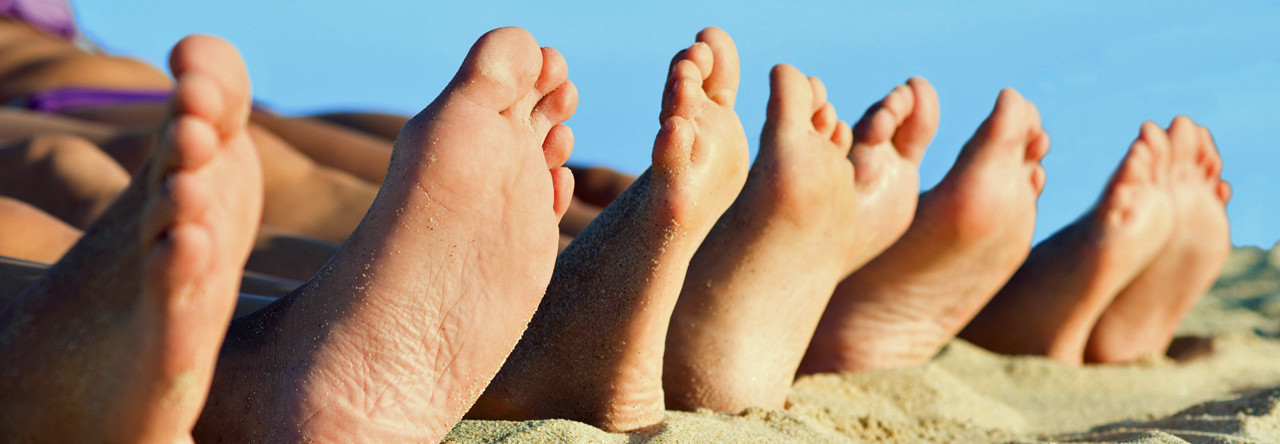3 out of 4 people in the US experience serious foot problems but only a small percentage is born with foot problems.
Each foot has 26 bones, 33 joints, 107 ligaments and 19 muscles. A quarter of all the bones in your body are in your feet.
Walking is the best exercise for your feet, contributing to general health by improving circulation.
Conditions like arthritis, diabetes, nerve and circulatory disorders can have their initial symptoms in the feet – so foot ailments can be your first sign of more serious medical problems.
Women have about four times as many foot problems as men. Doctors generally blame high heels for the difference.
Your two feet have about 250,000 sweat glands and can excrete as much as a cup of moisture per day.
Neglect and a lack of proper care, including ill fitting shoes, bring on foot problems.
If you put on weight, the bone and ligament structure of your feet might change. Get your shoe size rechecked to make sure you are buying shoes that are best for your feet.
Approximately 65% of people with diabetes have mild to severe forms of nerve damage, which in severe forms can create the need for lower limb amputations. Approximately 56,000 people a year lose a foot or leg to diabetes.
Walking barefoot can cause plantar warts. The virus enters through a cut.
Your two feet may be different sizes and the ball of the foot is twice as wide as the heel. Be sure to get shoes that fit.
About 5% of Americans have toenail problems in a given year.
The average person takes about 9,000 steps a day. That means that by 70 most people would have walked around the earth 4 times!
Category: Plantar Warts
“To minimize foot problems, just wear high heels for special occasions.” We have probably heard that before.
You love shoes. Shopping for them, trying them on and — most of all — buying them. Most professional women use high heels as part of their image. But what if your feet don’t feel so good, and they look even worse? Forced too often into the tight confines of the narrow toe box of your high heels, your toes bend into an unnatural positions. As a result, bumps and areas of thickened skin rub painfully against your shoes.
Are your beloved high heels the source of your foot problems? Yes, they probably are. High heels are one of the biggest factors leading to foot problems in women. The other is age. Frequently wearing high heels can set the stage for many common foot problems including blisters, calluses, corns, foot odor, hammer heel and others.
So, bottom line, wear them occasionally but consider other options for everyday.
Warts are actually benign tumors of the epidermis caused by a virus. The virus responsible is the human papillomavirus (HPV), a double-stranded DNA virus. The virus resides in the bottom layer of the epidermis and replicates into almost normal-looking skin.
Contrary to popular belief, warts do not have “roots”. They only grow in the top layer of skin, the epidermis. When they grow down, they displace the second layer of skin, the dermis. They do not grow into the dermis. The underside of a wart is actually smooth.
Salicylic acid is a very common and effective over-the-counter treatment, but requires consistent application every day. They best way to use salicylic acid is to first pare the wart with a blade, pumice stone, emery board, or small scrub brush. Soaking the wart in warm water will aid in the absorption of the medicine. Salicylic acid is applied to the wart and allowed to dry. Normal surrounding skin may be protected with petroleum jelly. Occluding the treated wart with a band-aid or piece of tape also improves the absorption of the medicine. This procedure should be repeated daily ideally around shower or bath time. Salicylic acid can be found in several forms including a thick oil, or incorporated into an adhesive plaster form.
Cryotherapy is another effective treatment of warts. Liquid nitrogen as a spray or on a cotton swab is applied to the wart freezes and kills the effected cells. The connective tissue is not destroyed; therefore, the lesion usually heals without significant scarring. The human papillomavirus is not killed by cryotherapy and is released into the surrounding tissue allowing the immune system to kill it. A blister typically forms on the site treated, crusts over, and falls off. Since blisters are painful to walk on, cryotherapy is not a first choice for warts on the bottom of the foot.
